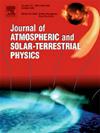Different microphysics parameterizations of hydrometeor pathways in WRF simulation: A case of two high rainfall events in Nigeria
IF 1.9
4区 地球科学
Q3 GEOCHEMISTRY & GEOPHYSICS
Journal of Atmospheric and Solar-Terrestrial Physics
Pub Date : 2025-02-06
DOI:10.1016/j.jastp.2025.106455
引用次数: 0
Abstract
This study evaluates the role and performance of microphysical processes and parameterizations in simulating two distinct rainfall events over Nigeria. Four microphysics (MP) schemes in the Weather Research and Forecasting (WRF) model—Goddard, Morrison, Thompson, and WDM6—were utilized. The analysis focused on mean rainfall rates, hydrometeor pathways, and spatial rainfall accumulation amounts and patterns.
Results indicate that while most MP schemes underestimated the mean rainfall rate, they reasonably captured the spatial distributions in both events. Based on statistical metrics of 24-h accumulated rainfall, the Goddard scheme produced the lowest mean absolute bias (MAB) and the highest rainfall detection ability (POD and TS) for the June rainfall event. For the February event, the Morrison scheme exhibited the least absolute bias and achieved high POD and TS values. The differences in rainfall production among the MP schemes were primarily attributed to variations in the growth rates of rainwater hydrometeors within the hydrometeor pathways (HPs), while rainfall duration was influenced by consistent collision and coalescence of cloud droplets. Excessive cloud water production also contributed to delays in rainwater formation, leading to reduced simulated rainfall. Additionally, the rapid melting of large graupel mass significantly affected the performance of different schemes in simulating rainfall. Furthermore, variations in low to mid-tropospheric vertical velocity and surface parameters (such as temperature and specific humidity) were shown to significantly control microphysical processes and, consequently, impact rainfall production.
Overall, the analysis suggests that more sophisticated MP schemes do not necessarily provide better simulations of precipitable hydrometeor pathways.
WRF模拟中水流星路径的不同微物理参数化:以尼日利亚两次高降雨事件为例
本研究评估了微物理过程和参数化在模拟尼日利亚两种不同降雨事件中的作用和表现。气象研究与预报(WRF)模式采用了goddard、Morrison、Thompson和wdm6四种微物理方案。分析的重点是平均降雨率、水成物路径和空间降水积累量和模式。结果表明,虽然大多数方案低估了平均降雨率,但它们较好地反映了这两个事件的空间分布。基于24 h累积降水统计指标,Goddard方案对6月降水事件的平均绝对偏差(MAB)最低,降水检测能力(POD和TS)最高。对于2月的事件,Morrison方案表现出最小的绝对偏差,并且获得了较高的POD和TS值。降雨产生的差异主要归因于水成物路径(HPs)内雨水水成物生长速率的变化,而降雨持续时间则受到云滴持续碰撞和聚并的影响。过量的云水产生也导致了雨水形成的延迟,导致模拟降雨量减少。此外,大霰团的快速融化对不同方案的模拟效果有显著影响。此外,对流层中低层垂直速度和地表参数(如温度和比湿度)的变化显示出对微物理过程的显著控制,从而影响降雨的产生。总的来说,分析表明,更复杂的MP方案不一定能更好地模拟可降水的水流星路径。
本文章由计算机程序翻译,如有差异,请以英文原文为准。
求助全文
约1分钟内获得全文
求助全文
来源期刊

Journal of Atmospheric and Solar-Terrestrial Physics
地学-地球化学与地球物理
CiteScore
4.10
自引率
5.30%
发文量
95
审稿时长
6 months
期刊介绍:
The Journal of Atmospheric and Solar-Terrestrial Physics (JASTP) is an international journal concerned with the inter-disciplinary science of the Earth''s atmospheric and space environment, especially the highly varied and highly variable physical phenomena that occur in this natural laboratory and the processes that couple them.
The journal covers the physical processes operating in the troposphere, stratosphere, mesosphere, thermosphere, ionosphere, magnetosphere, the Sun, interplanetary medium, and heliosphere. Phenomena occurring in other "spheres", solar influences on climate, and supporting laboratory measurements are also considered. The journal deals especially with the coupling between the different regions.
Solar flares, coronal mass ejections, and other energetic events on the Sun create interesting and important perturbations in the near-Earth space environment. The physics of such "space weather" is central to the Journal of Atmospheric and Solar-Terrestrial Physics and the journal welcomes papers that lead in the direction of a predictive understanding of the coupled system. Regarding the upper atmosphere, the subjects of aeronomy, geomagnetism and geoelectricity, auroral phenomena, radio wave propagation, and plasma instabilities, are examples within the broad field of solar-terrestrial physics which emphasise the energy exchange between the solar wind, the magnetospheric and ionospheric plasmas, and the neutral gas. In the lower atmosphere, topics covered range from mesoscale to global scale dynamics, to atmospheric electricity, lightning and its effects, and to anthropogenic changes.
 求助内容:
求助内容: 应助结果提醒方式:
应助结果提醒方式:


